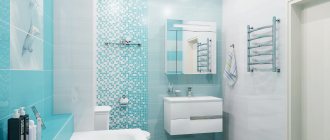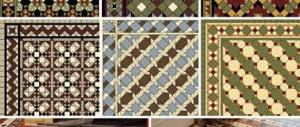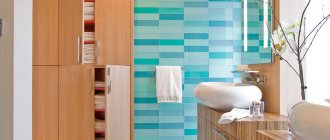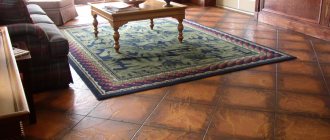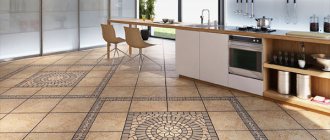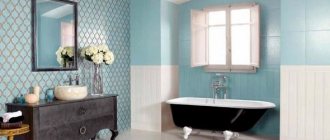Advantages of porcelain tiles in the interior
Tiles in the Shabby Chic interior especially attract the attention of designers, as well as qualified construction workers and ordinary citizens who have decided to update the design of their apartment or country house. The most significant advantages include:
- the use of artificial material that is not subject to age-related changes, due to which it always remains in its original state. The appearance and operational period remain at the maximum level, regardless of the room in which installation is planned;
- Porcelain stoneware in the interior is an environmentally friendly coating. You can personally verify this by studying the composition from which it is made. It includes: quartz sand, clay, kaolin and spar, which provides it with an unlimited service life;
- high strength indicators that are not subject to challenge. A distinctive feature is resistance to severe frosts, increased humidity, and increased load volumes;
- no need for constant care. It cannot be affected by numerous chemicals, and any contamination can be quickly cleaned with a simple wave of a wet cloth;
- a wide range of porcelain tiles, which includes not only an abundance of colors, but also textures. For example, mirror tiles in the kitchen interior can emphasize individuality.
The presence of numerous advantages makes porcelain tiles the best finishing material, which is distinguished by its relatively low cost and long service life.
Disadvantages of porcelain tiles in the interior
Any floor covering has not only advantages, but also certain disadvantages. It is extremely important to familiarize yourself with them in advance to eliminate the possibility of misunderstandings in the future.
The negative aspects of porcelain tiles are:
- the finishing material is considered cold, but this is normal for use as a floor covering. This especially affects those who like to walk on tiles barefoot. One solution to the problem may be the additional installation of a heated floor system, but this automatically entails an increase in costs associated with paying for electricity. If you want to install a warm water floor, you must first obtain permission from representatives of a specialized agency;
- The finishing material is produced artificially, which is why it does not include those properties that natural stones automatically acquire with age - the absence of the “beautiful aging” effect. Often glossy finishing material acquires scratches and cracks. It is impossible to restore defects in the future;
- During the work of laying the finishing material, it is impossible to exclude butt seams, which will become noticeable in any case to others. Rarely, there are situations when it is impossible to use this option, since it creates an unaesthetic appearance, which is why you need to think through everything carefully;
- The floor covering is rigid and impressively thick. Whether this is relevant or not, everyone must decide for themselves, depending on the tasks assigned. At the same time, you need to understand that if, for example, you drop a mug, a phone or an ordinary wristwatch, in most cases they will be broken. In rooms where the ceiling height is small, greater thickness has a negative effect, since it significantly reduces the area.
Also on topic: Finishing the base with porcelain stoneware: the right option for cladding
Mirror tiles in the living room interior are considered a very fragile finishing material. It is for this reason that if you lack installation experience, it is advisable to seek help from qualified specialists who are ready to provide a guarantee on the result obtained.
Ceramic tile
Ceramic tile flooring option
In colloquial language, ceramic tiles are usually called tiles. It is a solid material, used in cladding not only residential, but also industrial premises. And due to the variety of colors, textures and patterns, it serves as an excellent design tool in the design of any interiors. Ceramic tiles are produced by pressing and then firing the composite. The composition is completely natural: sand, clay, minerals. Next, it is coated with special enamel and sent back to the oven. This tile is great for laying on walls, as it is more porous and has a low weight and thickness. The second type of tile is pressed using a more powerful machine, in this way its structure loses porosity and it becomes more elastic and thick, as a result of which its wear-resistant qualities increase. In this case, it requires only one firing stage, which is carried out immediately with the enamel and at a higher temperature. As a result, the tiles that come out of the oven are quite dense and wear-resistant; they can be used for laying on the floor without any problems.
Advantages:
- Moisture resistance
- Does not require much care
- Keeps the look for a long time
- Huge selection of colors
- Inexpensive price
- Low weight
This material has proven itself when decorating walls in the bathroom and when laying an apron in the kitchen work area. Matte representatives of ceramics look gorgeous when used to decorate floors in corridors. Ceramic tiles are very easy to clean and create an aesthetically beautiful interior.
Using porcelain tiles in the living room
Tiles in the living room interior , made from porcelain stoneware, can emphasize the individual style of the owner of an apartment or country house and emphasize character. Use in such rooms has become relevant not so long ago. A few years ago it was believed that finishing material could be used for some premises:
- bathroom;
- kitchens.
However, the wide range of products on the market has forced designers and home owners to reconsider their vision. Finishing materials that are similar in color to natural ones are in particular demand.
Experts recommend giving preference to a neutral color shade, since it has a maximum service life due to its different texture.
The main disadvantage is the presence of a cold floor effect, without taking into account the use of warm color tones and the cozy arrangement of the living room. This causes additional financial costs that are directly related to the installation of a floor heating system - the purchase of the necessary material and energy costs. By paying attention to such features, you can avoid misunderstandings in the future.
Porcelain tiles or ceramic tiles: which is better?
Despite the abundance of finishing materials on the modern market, ceramic coatings still remain the most popular today. The secret is their reliability and resistance to aggressive external influences. It is tile that is preferred when a practical and durable finish is required in rooms with high levels of humidity: bathrooms, toilets, toilets, etc.
If not so long ago everyone knew only one type of cladding - ceramic tiles, then in recent years durable and beautiful porcelain tiles have successfully competed with it. Naturally, when choosing, the question becomes relevant: what is the difference between ceramic tiles and porcelain stoneware? We invite you to figure it out together.
As mentioned above, tiles are indispensable for wet rooms. In addition, it is widely used in the kitchen, especially for arranging a work wall or floor. This material is easy to maintain on a daily basis, easy to clean and wash, often with plain water, without the use of chemicals. It is made by pressing and further firing a mixture of clay, sand and organic minerals.
But the main difference between porcelain stoneware and ceramic floor tiles is that the former has a denser, harder body, achieved during the production process. Ceramic granite, as a rule, is baked at high temperatures; its color is already initially included in the composition of the mixture, which makes it possible to achieve uniformity throughout the entire thickness of the product. It does not need additional enamel like tile. The finished mixture is molded, dried and pressed, after which it is re-pressed under a more powerful press, and then fired at a temperature of 1200-1300 degrees.
Thanks to this technology, porcelain stoneware has much lower porosity and absorbs less moisture, which significantly increases its strength. Despite the fact that both materials are covered with glaze, the difference between porcelain stoneware and ceramic tiles is that the first can be used outdoors, which cannot be said about the second. Homogeneous, fully painted porcelain granite is also currently available, recommended for commercial areas.
However, despite all the obvious advantages of this coating, it is not without its drawbacks. Firstly, porcelain stoneware has a lot of weight, which, of course, cannot but affect the difficulty of processing and cutting it. Secondly, we should note its higher price, and thirdly, the variety of colors and patterns is not as wide as that of its competitor.
But even the listed disadvantages of these two materials do not prevent them from still holding the palm in the international market. The unique characteristics of ceramics for walls and floors make it especially popular and in demand nowadays in both private and public construction. Therefore, to give a clear answer to the question: “porcelain tiles or ceramic tiles: which is better?” almost impossible, since each of the facing materials has its own area of application, where they have no equal yet.
The difference between the manufacturing technology of ceramic tiles and porcelain stoneware
The features and properties of porcelain stoneware and ceramic tiles are determined primarily by the manufacturing technology of the materials. To better understand the characteristics and logic of their use, it is worth familiarizing yourself a little more with the nuances of the production of both types of tiles.
Production of ceramic tiles
For the manufacture of ceramic tiles, raw materials are used, which include the following components:
#1. Clay. For the production of tiles, refractory or refractory types of clay are used. In this case, the first option is preferable, since it allows you to obtain a more durable material.
#2. Quartz sand. Necessary for increased strength and preservation of the shape of the tiles after firing.
#3. Feldspar compositions are a mixture of minerals, sodium and potassium aluminosilicates. They provide raw materials with viscosity sufficient for molding and increasing the strength of the material under the influence of high temperatures.
If necessary, the raw materials are supplemented with various additives - plasticizers, fluxes and vapor-forming components to quickly remove moisture.
In general terms, the production of ceramic tiles is carried out in several stages:
- preparation of raw materials, mixing of main components and additives in the required proportions;
- molding of products, pressing under pressure of about 400 kg/cm2;
- drying pressed tiles;
- glazing of tiles (to give the material the desired color);
- firing at temperatures from 900 to 1300 degrees.
After processing of the tiles is completed, sorting is carried out - the uniformity of firing and the thickness of each product are assessed, and failed elements are rejected.
There are two cycles for the production of ceramic tiles - with single or double firing. Double-fired material, also known as bicottura , is exposed to high temperatures twice to create the base and set the enamel. Such tiles are more fragile and porous, and therefore are only suitable for finishing indoor walls.
Ceramics that have gone through one firing cycle, but after pressing under increased pressure and at higher temperatures (up to 1200 degrees) are called monocottura. These tiles are thicker and more durable, which allows them to be used both for creating flooring and for interior and exterior wall decoration.
Production of porcelain stoneware
For the production of porcelain stoneware, press powder obtained from slip is used.
This is the name given to a plastic porcelain mixture consisting of the following components:
#1. White clay (kaolin). Necessary for high viscosity, strength and fire resistance of finished products.
#2. Illite clay (formation of sheet silicates). Provides greater plasticity during the process of molding products, and subsequently allows you to obtain a homogeneous material with high mechanical stability.
#3. Feldspar. Provides porcelain stoneware resistance to aggressive chemicals.
#4. Quartz sand. Essential for wear resistance and hardness.
#5. Mineral dyes (introduced into the finished press powder).
After absolute homogeneity of the raw materials has been achieved, the production of porcelain tiles sequentially goes through several stages:
- molding of tiles with long-term pressing under high pressure (500 kg/cm2) and active drying;
- drawing or glazing;
- firing of products in ovens at a temperature not lower than 1200 degrees;
- polishing or grinding tiles (for certain types of porcelain stoneware).
When the technology is strictly followed, porcelain stoneware acquires a special, incredibly durable, smooth and uniform structure, without any foreign inclusions or internal voids.
The similarities between the production of ceramic tiles and porcelain stoneware are obvious. However, although small, the difference in the components for raw materials and the use of higher pressure and temperature in the manufacture of porcelain stoneware reveal even more differences between the materials - they will be discussed below.
